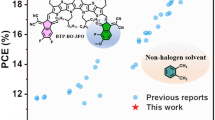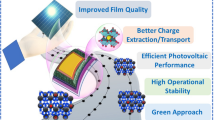Abstract
We fabricated inverted polymer solar cells (PSCs) with the structure of ITO/ZnO NPs/Active layer/MoO3/Ag, in which ZnO NPs act as electron transport layer (ETL), poly{4,8-bis[(2-ethylhexyl)oxy]benzo[1,2-b:4,5-b0]-dithiophene-2,6-diyl-alt-3-fluoro-2-[(2-ethylhexyl)carbonyl]thieno[3,4-b]thiophene-4,6-diy (PTB7) as donor and [6,6]-phenyl-C71-butyric-acidmethyl-ester (PC71BM) as accepter. It is found that the temperature employed during the annealing process of ZnO NPs has significant impact on the efficiency of the resulted PSCs. The optimized PSC with ZnO NPs annealed at 150 °C based on PTB7:PC71BM (1:1.5 w/w) exhibited a power-conversion efficiency of 7.37% with open-circuit voltage (Voc) of 0.722 V, short-circuit current density (Jsc) of 15.38 mA cm−2, and fill factor (FF) of 66.4%. The effects of the annealing temperature on photovoltaic performances were further illustrated with transmission spectrum, atomic force microscopy, X-ray diffraction and PL spectra, meanwhile electrical performance were illustrated with conductivity. Our result indicated that the improved efficiency is due to the optimized ETL/active layer interface, the enhanced transparency and electron transport of the ETLs. As its facile preparation process, this kind of ETL is compatible with roll-to-roll manufacturing of larger area flexible PSCs.








Similar content being viewed by others
References
Small CE, Chen S, Subbiah J, Amb CM, Tsang S-W, Lai T-H, Reynolds JR, So F (2012) High-efficiency inverted dithienogermole-thienopyrrolodione-based polymer solar cells. Nat Photonics 6:115
Li G, Chu C-W, Shrotriya V, Huang J, Yang Y (2006) Efficient inverted polymer solar cells. Appl Phys Lett 88:253503
Chen LM, Hong Z, Li G, Yang Y (2009) Recent progress in polymer solar cells: manipulation of polymer: fullerene morphology and the formation of efficient inverted polymer solar cells. Adv Mater 21:1434
Sun Y, Seo JH, Takacs CJ, Seifter J, Heeger AJ (2011) Inverted polymer solar cells integrated with a low-temperature-annealed sol–gel-derived ZnO film as an electron transport layer. Adv Mater 23:1679
Liang Y, Yu L (2010) A new class of semiconducting polymers for bulk heterojunction solar cells with exceptionally high performance. Acc Chem Res 43:1227
Park SH, Roy A, Beaupré S, Cho S, Coates N, Moon JS, Moses D, Leclerc M, Lee K, Heeger AJ (2009) Bulk heterojunction solar cells with internal quantum efficiency approaching 100%. Nat Photonics 3:297
Blouin N, Michaud A, Gendron D, Wakim S, Blair E, Neagu-Plesu R, Belletete M, Durocher G, Tao Y, Leclerc M (2008) Toward a rational design of poly(2,7-carbazole) derivatives for solar cells. J Am Chem Soc 130:732
Ma W, Yang C, Gong X, Lee K, Heeger AJ (2005) Thermally stable, efficient polymer solar cells with nanoscale control of the interpenetrating network morphology. Adv Funct Mater 15:1617
Li G, Shrotriya V, Huang J, Yao Y, Moriarty T, Emery K, Yang Y (2005) High-efficiency solution processable polymer photovoltaic cells by self-organization of polymer blends. Nat Mater 4:864
Peet J, Kim JY, Coates NE, Ma WL, Moses D, Heeger AJ, Bazan GC (2007) Efficiency enhancement in low-bandgap polymer solar cells by processing with alkane dithiols. Nat Mater 6:497
Hauch JA, Schilinsky P, Choulis SA, Childers R, Biele M, Brabec CJ (2008) Flexible organic P3HT: PCBM bulk-heterojunction modules with more than 1 year outdoor lifetime. Sol Energy Mater Sol Cells 92:727
Lungenschmied C, Dennler G, Neugebauer H, Sariciftci SN, Glatthaar M, Meyer T, Meyer A (2007) Flexible, long-lived, large-area, organic solar cells. Sol Energy Mater Sol Cells 91:379
Brabec CJ, Gowrisanker S, Halls JJ, Laird D, Jia S, Williams SP (2010) Polymer–fullerene bulk-heterojunction solar cells. Adv Mater 22:3839
Hung L, Tang CW, Mason MG (1997) Enhanced electron injection in organic electroluminescence devices using an Al/LiF electrode. Appl Phys Lett 70:152
Kawano K, Pacios R, Poplavskyy D, Nelson J, Bradley DD, Durrant JR (2006) Degradation of organic solar cells due to air exposure. Sol Energy Mater Sol Cells 90:3520
De Jong M, Van Ijzendoorn L, De Voigt M (2000) Stability of the interface between indium-tin-oxide and poly(3,4-ethylenedioxythiophene)/poly (styrenesulfonate) in polymer light-emitting diodes. Appl Phys Lett 77:2255
Jørgensen M, Norrman K, Krebs FC (2008) Stability/degradation of polymer solar cells. Sol Energy Mater Sol Cells 92:686
Yan H, Lee P, Armstrong NR, Graham A, Evmenenko GA, Dutta P, Marks TJ (2005) High-performance hole-transport layers for polymer light-emitting diodes. Implementation of organosiloxane cross-linking chemistry in polymeric electroluminescent devices. J Am Chem Soc 127:3172
Norrman K, Gevorgyan SA, Krebs FC (2008) Water-induced degradation of polymer solar cells studied by H 182 O labeling. ACS Appl Mater Interfaces 1:102
Krebs FC (2009) All solution roll-to-roll processed polymer solar cells free from indium-tin-oxide and vacuum coating steps. Org Electron 10:761
Desai A, Haque M (2007) Mechanical properties of ZnO nanowires. Sens Actuators A 134:169
Yang T, Cai W, Qin D, Wang E, Lan L, Gong X, Peng J, Cao Y (2010) Solution-processed zinc oxide thin film as a buffer layer for polymer solar cells with an inverted device structure. J Phys Chem C 114:6849
Chen S, Small CE, Amb CM, Subbiah J, Lai Th, Tsang SW, Manders JR, Reynolds JR, So F (2012) Inverted polymer solar cells with reduced interface recombination. Adv Energy Mater 2:1333
Fonoberov VA, Alim KA, Balandin AA, Xiu F, Liu J (2006) Photoluminescence investigation of the carrier recombination processes in ZnO quantum dots and nanocrystals. Phys Rev B 73:165317
Klenk R (2001) Characterisation and modelling of chalcopyrite solar cells. Thin Solid Films 387:135
Sun X, Li C, Huang L, Xu R, Ni J, Cai H, Li J, Zhang J (2017) Effects of high-boiling-point additive 2-bromonaphthalene on polymer solar cells fabricated in ambient air. Polym Bull 74(11):4515–4524
Sun X, Ni J, Li C, Huang L, Xu R, Li Z, Cai H, Li J, Zhang J (2016) Air-processed high performance ternary blend solar cell based on PTB7-Th:PCDTBT:PC 70 BM. Org Electron 37:222
Sun B, Sirringhaus H (2005) Solution-processed zinc oxide field-effect transistors based on self-assembly of colloidal nanorods. Nano Lett 5:2408
Zak AK, Abrishami ME, Majid WA, Yousefi R, Hosseini S (2011) Effects of annealing temperature on some structural and optical properties of ZnO nanoparticles prepared by a modified sol–gel combustion method. Ceram Int 37:393
Zak AK, Majid WA, Abrishami ME, Yousefi R (2011) X-ray analysis of ZnO nanoparticles by Williamson-Hall and size–strain plot methods. Solid State Sci 13:251
Morvillo P, Diana R, Ricciardi R, Bobeico E, Minarini C (2015) High efficiency inverted polymer solar cells with solution-processed ZnO buffer layer. J Sol Gel Sci Technol 73:550
Chen H-Y, Hou J, Zhang S, Liang Y, Yang G, Yang Y, Yu L, Wu Y, Li G (2009) Polymer solar cells with enhanced open-circuit voltage and efficiency. Nat Photonics 3:649
Iannaccone G, Bernardi A, Suriano R, Bianchi CL, Levi M, Turri S, Griffini G (2016) The role of sol–gel chemistry in the low-temperature formation of ZnO buffer layers for polymer solar cells with improved performance. RSC Adv 6:46915
Wang G, Jiu T, Tang G, Li J, Li P, Song X, Lu F, Fang J (2014) Interface modification of ZnO-based inverted PTB7:PC71BM organic solar cells by cesium stearate and simultaneous enhancement of device parameters. ACS Sustain Chem Eng 2:1331
Lv L, Lu Q, Ning Y, Lu Z, Wang X, Lou Z, Tang A, Hu Y, Teng F, Yin Y (2014) Self-assembled TiO2 nanorods as electron extraction layer for high-performance inverted polymer solar cells. Chem Mater 27:44
Huang X, Lv L, Hu Y, Lou Z, Hou Y, Teng F (2017) Enhanced performance in inverted polymer solar cells employing microwave-annealed sol–gel ZnO as electron transport layers. Org Electron 42:107
Chen M, Wang X, Yu Y, Pei Z, Bai X, Sun C, Huang R, Wen L (2000) X-ray photoelectron spectroscopy and auger electron spectroscopy studies of Al-doped ZnO films. Appl Surf Sci 158:134
Natsume Y, Sakata H (2000) Zinc oxide films prepared by sol–gel spin-coating. Thin Solid Films 372:30
Wan Q, Yu K, Wang T, Lin C (2003) Low-field electron emission from tetrapod-like ZnO nanostructures synthesized by rapid evaporation. Appl Phys Lett 83:2253
Islam MN, Ghosh T, Chopra K, Acharya H (1996) XPS and X-ray diffraction studies of aluminum-doped zinc oxide transparent conducting films. Thin Solid Films 280:20
Lee EJ, Heo SW, Han YW, Moon DK (2016) An organic–inorganic hybrid interlayer for improved electron extraction in inverted polymer solar cells. J Mater Chem C 4:2463
Acknowledgements
This work was supported by the National Natural Science Foundation of China (no. 61377031), the National Natural Science Foundation of China (Grant no. 61404073) and the Natural Science Foundation of Tianjin (Grant no. 17JCYBJC21200).
Author information
Authors and Affiliations
Corresponding author
Rights and permissions
About this article
Cite this article
Xu, R., Sun, X., Li, C. et al. Correlating annealing temperature of ZnO nanoparticle electron transport layer with performance of inverted polymer solar cells. Polym. Bull. 75, 4397–4408 (2018). https://doi.org/10.1007/s00289-018-2279-0
Received:
Revised:
Accepted:
Published:
Issue Date:
DOI: https://doi.org/10.1007/s00289-018-2279-0




